
Ecommerce Copywriting Guide: How to Write Copy that Sells
Is there such a thing as website copy that sells? (Spoiler alert: Science suggests that the answer is yes.)
Language has an undoubted impact on how people perceive the world around them. According to the Linguistic Relativity Hypothesis, language affects both world perception and thought, a theory proven in 2008 with the help of functional magnetic resonance imaging. And, over the past decade, ecommerce-specific research has shown that copywriting plays a crucial role in ensuring online retail success.
For example, a 2014 study looked at the connection between emotional language in product reviews and commerce. Interestingly, it found that strongly worded emotions had a positive impact on the sales of hedonic products. Another research project from 2017 looked at over 90,000 product descriptions to try and identify writing styles and words that would predict sales. They found that the elements that drove the best results included appeals to authority, polite language, and informative and seasonal words.
So, if the way you describe your product, present your unique value proposition, or encourage web visitors to convert has a direct impact on your sales, it’s only natural that you’ll want to improve your website copy.
This ecommerce copywriting guide will teach you just that: How to use language that sells.
Why Great Copy Matters
While a scientific approach to copywriting may not be everyone’s cup of tea, there are a few undoubted benefits of investing in your ecommerce website copy.
Some of the advantages of getting your wording just right include:
- More Conversions: Finding effective ways to describe your products and services is, without a doubt, going to convince more visitors to convert, positively affecting your bottom line
- More Effective Nurturing: Using the right words at the right time can help you communicate the perfectly timed message for your audience’s position in the sales funnel. Consequently, by writing ecommerce copy with the buyer’s journey in mind, you cannot just capture more leads but also ensure that you nurture mere web visitors into loyal customers of your brand
- SEO Benefits: Great copy takes search engine optimization into mind, strategically using keywords to increase your site’s visibility on SERPs, winning you organic traffic you can turn into conversions
- Triggering Positive Feelings & Emotional Buy-In From Customers: Nailing your brand’s voice in your website copy is one of the best ways to build an emotional connection with your audience, driving them to become supporters and champions of your business
- Differentiating Your Brand from the Competition: Website copy is an excellent way to show web visitors how your brand differs from the competition. Remember, consumers might prioritize value and price when making purchase decisions, but they also make decisions based on trust, reputation, and emotional connection when choosing what brands to buy from
The Importance of Speaking Your Customers’ Language
One of the best methods for planning marketing strategies is to concentrate on practices that have proven to yield results.
This doesn’t just mean keeping an eye on analytical data to determine whether current copywriting methods effectively drive conversions. But, it also means doing continual research into consumer sentiment to understand people’s prevailing pain points, ever-changing shopping behaviors, and prioritized values (which are currently shifting in most industries).
Approaching the writing process with these in mind will allow you to write the absolute best website copy that appeals to your target audience and builds connections over your shared values.
Why Research Is Important
There are several common mistakes that business owners (and even some copywriters) make when starting the writing process. The biggest one of these is, without a doubt, allowing themselves to follow their instincts instead of data.
You see, more often than not, landing pages and product pages use copy that seems relevant to the brand’s mission. Writers or business owners decide to write copy they think will work without actually doing the research to validate their language choices.
The result? Web pages that look and sound great but unfortunately, do not convert.
Luckily, there is an easy solution to avoiding this problem — thorough research.
By looking for the correct cues, brands can effectively identify the language and voice that appeals to their target audience. Eventually, this leads to better ways of communicating brand values/product benefits and results in sales.
Know Your Audience
Perhaps the best way to identify language that sells is to properly get to know your audience.
Creating buyer personas, understanding their pain points, concerns, and motivations is a crucial step of the copywriting process, as it highlights the sales points that deserve emphasis. And, once you have all this data, you can put it to good use on your product or landing pages.
Just check out how well Asana’s copywriting team does this on the Asana vs. Monday.com landing page.
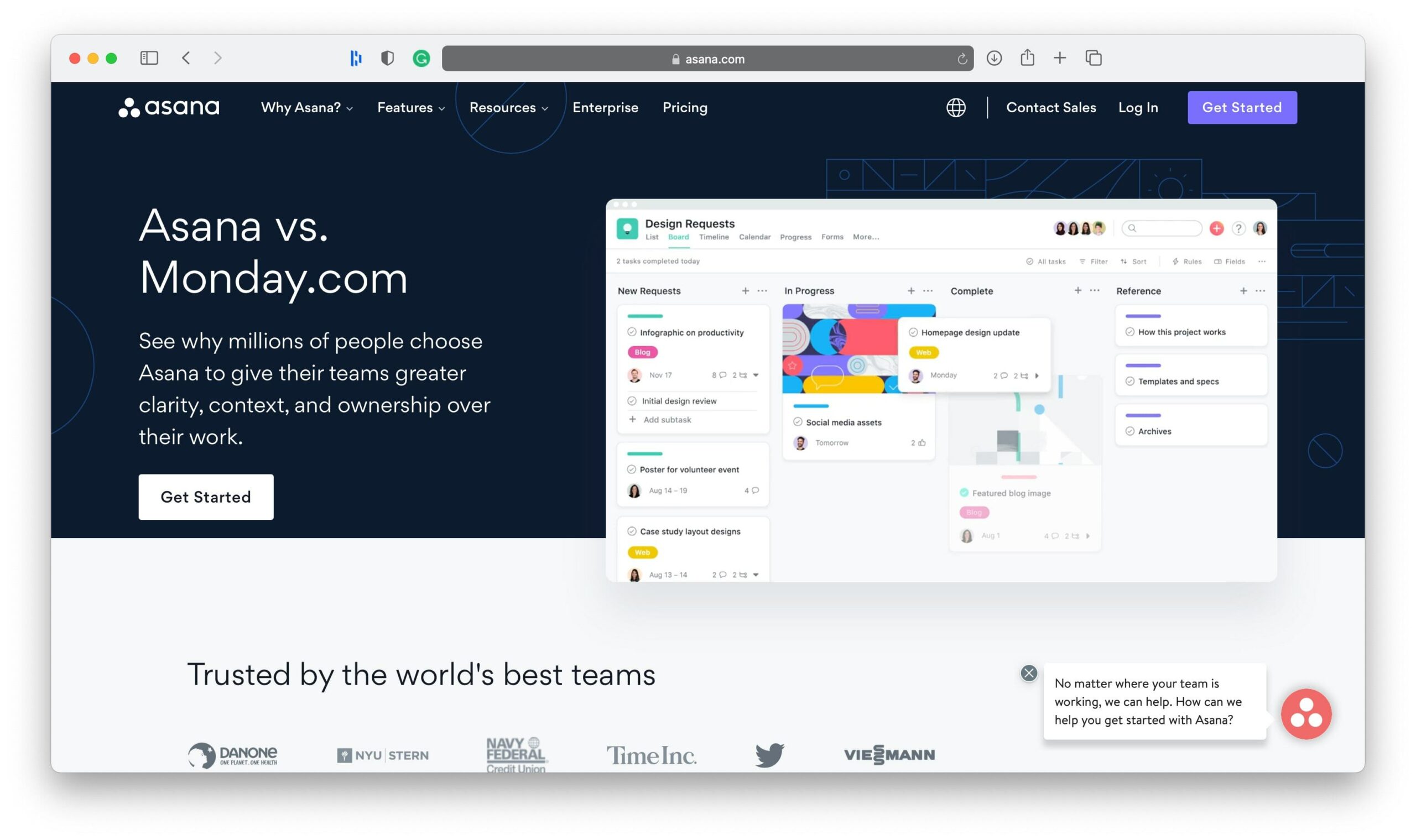
Source: asana.com
The key phrases used to differentiate between the two software options include clarity, control, ownership, transparency, value, speed, and less effort.
Plus, if you take a close look, you’ll see that the brand points out several times that its free trial lasts twice as long as Monday.com’s. This signals that Asana knows what new users want and understands how to present its offer to secure success.
Watch Your Tone
You don’t just have to know what your audience wants, but you also have to understand what type of brand they want to support.
Perhaps they’re looking for a reliable company? Or, they could be looking for a brand that’s fun and exciting. They may be focused on aesthetics. Or they may be looking for a brand that inspires and motivates them to go after their goals.
When writing copy for your website, you have to keep the tone of voice in mind. Read the room (that is, research your audience) and find the best ways to talk to potential customers.
You might find that the most effective way to approach website visitors is to appeal to their rationale — as is done by Udemy with its no-nonsense professional tone that is fully geared towards positioning the brand as a trustworthy educational resource.
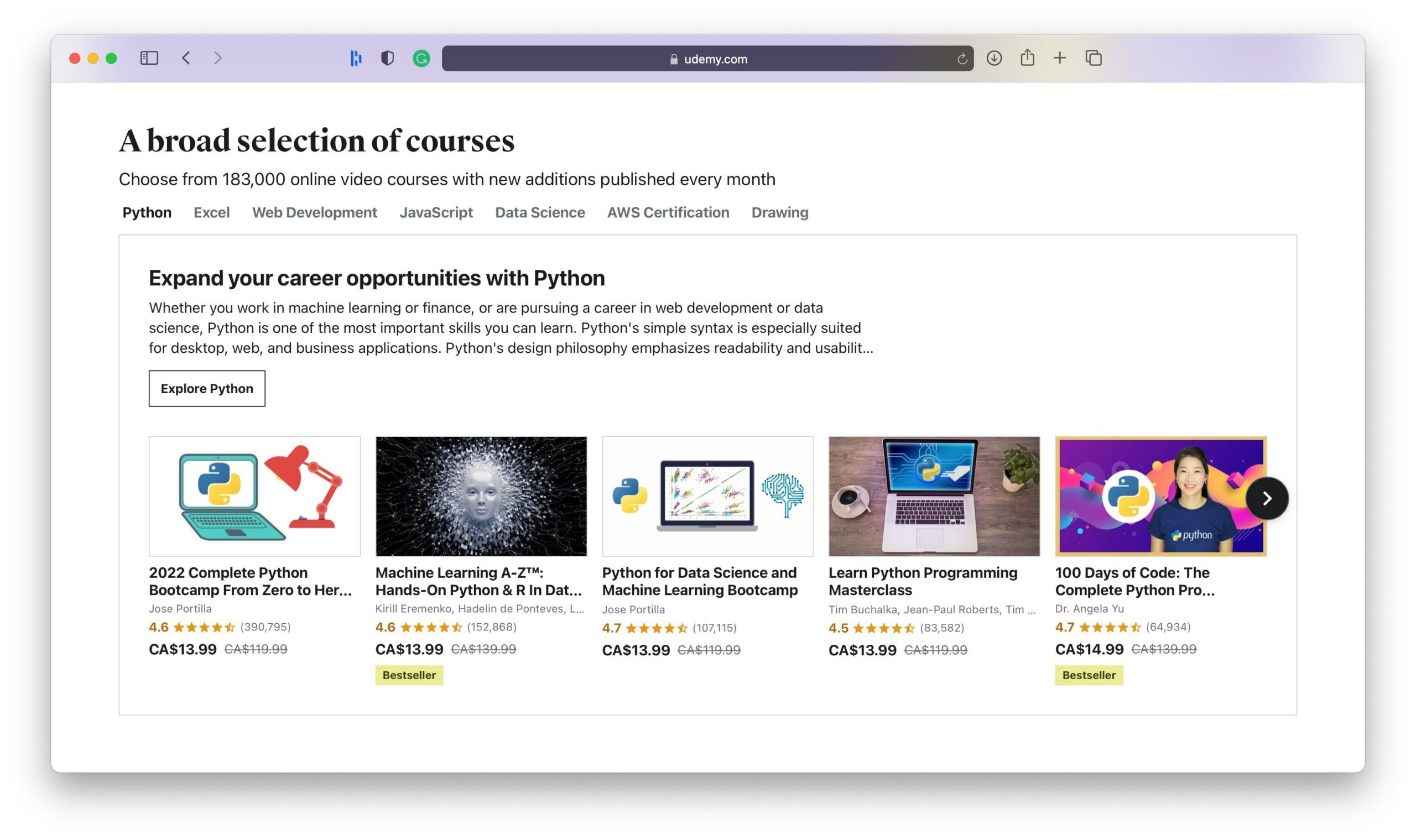
Source: udemy.com
But, you might also find your audience responding better to a motivational tone that appeals to people’s self-actualization needs and inspires them to take action to achieve their full potential. Monthly, for example, has done that.
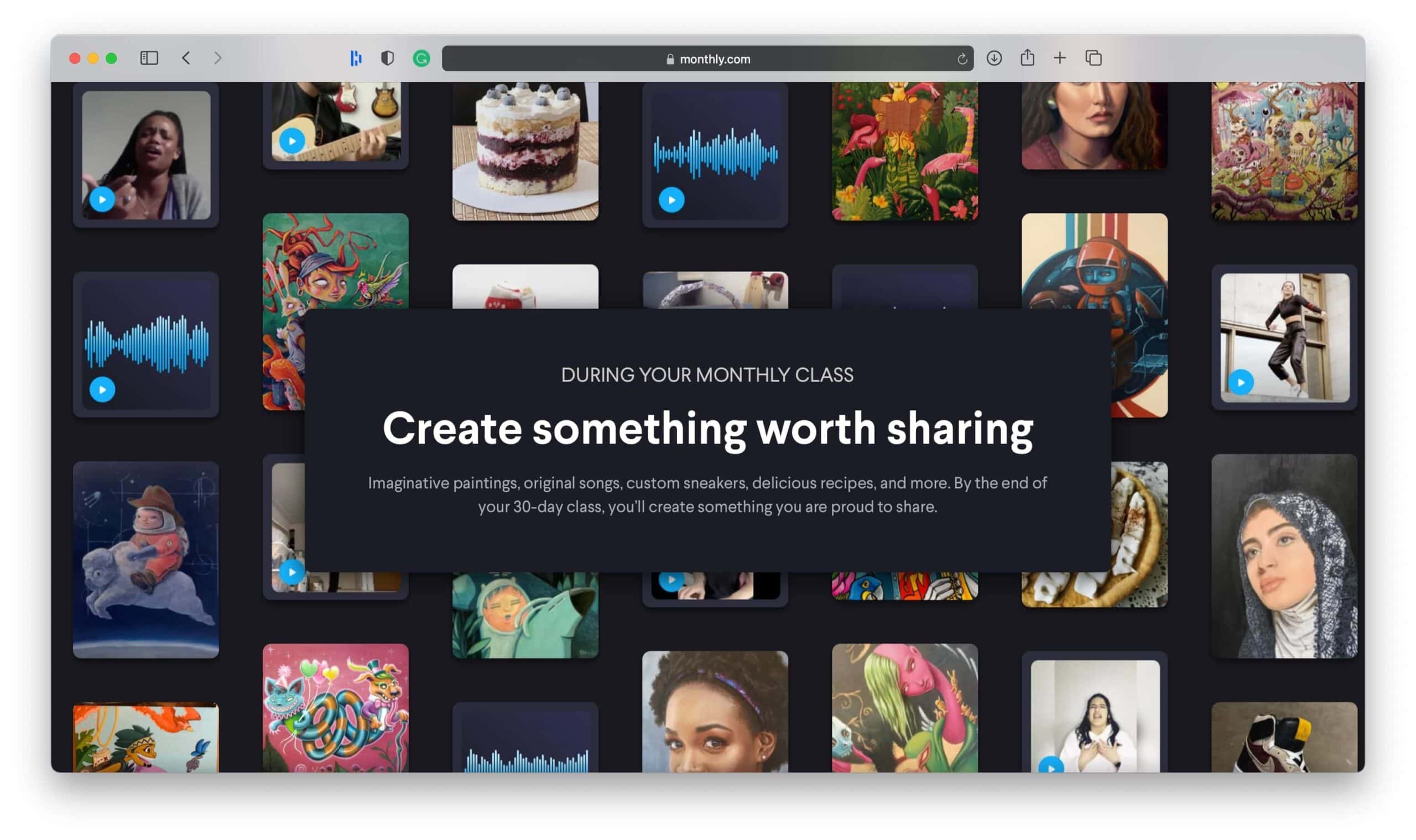
Source: monthly.com
Furthermore, note that while your brand’s voice needs to be consistent through all your distribution channels, the tone will differ based on where and what you’re trying to communicate. In other words, your Terms of Service page will have to sound far more professional than the caption to a meme you share on social media.
Tap Into the Knowledge You Have Access To
Considering everything that goes into writing web copy that sells, you might find yourself overwhelmed by the idea of doing the research and gathering all the relevant information to start.
But the thing is, you likely already have access to a great deal of valuable data that will help you turn your average website copy into language that actually sells.
For example, a simple Google search can provide insights about what users have found useful when searching for specific keywords.
Because of the search engine’s advanced algorithm, the top results will be the ones that have proven to be relevant to users’ queries, present relevant information, provide high-quality content, and offer an exceptional user experience.
You can analyze these results to check what type of words they use, how they construct sentences, and what CTAs they utilize to convince customers to convert. Then, you can try to find ways to recreate what works on these pages. Just make sure that you add your brand’s unique touch and emphasize the things your company does better than the competition.
Then, of course, there are your existing clients. Look for feedback from both those whom you’ve successfully nurtured into return customers and those who only purchased once then moved on to your competition.
Great ways to do your research include the following…
Engaging with Website Visitors
The easiest way to enhance your website copy is to talk to web visitors in real-time. Simply use live chat software (or, in some cases, chatbots).
Engage website visitors, offer them your help, and keep your ears open. More likely than not, they’ll tell you exactly what they’re looking for. Moreover, they’ll use the wording that appeals to them the most, which can give you the precious opportunity to identify keywords and sentiments your website copy should reflect to successfully sell your products and services.
Going Through Support Logs
Another excellent research method to identify your customers’ language is to go through your support logs. Recognizing the pain points of your existing customers, you can not only work to make your products better, but you can also find opportunities to adequately describe those products through your copy, effectively managing customer expectations and preventing disappointments by being more precise with what you promise to your clients.
Conducting Surveys to Find Pain Points
Do you have a sizable number of repeat and one-time buyers? Why not put together a survey which will help you recognize your audience’s pain points. Ask questions such as:
- What did you need to solve that led you to our product/service?
- What were your priorities when choosing solutions?
- What benefits made you continue subscribing to our product/opt for a different solution?
- Who would you recommend our product to?
- Who would you advise against getting our product and why?
- What changes would improve your overall experience/convince you to give our product another try?
Identifying FAQs
Another super-valuable source of information for copywriters is the frequently asked questions your support/sales teams receive.
Do your web visitors often ask for clarifications on product features? Do they have questions regarding shipping or payment processes? Any question that arrives in your company’s inbox more than a couple of times provides clues on valuable information that deserves to be on your site.
Looking at Information Collected Through CRM Software
If your ecommerce business uses CRM software, then it might not be a bad idea to take a look at the information available about your most loyal customers. Seeing how most of these solutions offer advanced customer insights, it would be foolish not to use them to optimize your website for conversions and fine-tune the language you use so that you ensure higher satisfaction rates from your buyers.
Reading Product Reviews to Find Information
Finally, don’t underestimate the value of product reviews, which are a great resource to check out if you want to know about the pain points that brought your clients to you, the benefits they found most valuable, as well as the main objections they had towards becoming your customers.
How to Write Great Copy for Your Ecommerce Store
Now that you understand the steps that go into recognizing the ideal language, voice, and tone for your brand, it’s time to get down to business.
But before you come up with a formula and start applying it to all your distribution channels and digital assets, you have to accept that different formats require different types of communication. That’s why the best way forward is to break up your copywriting efforts into categories based on the distribution channel you’re writing for.
Here’s how you can produce copy that drives conversions for all of your ecommerce brand’s needs.
Adverts
Considering that paid ads cost money, optimizing your copy is one of the best ways to boost ROI.
In addition to targeting the right audience segments and linking to relevant landing pages, there are a few proven-to-work tricks to increase the efficiency of your PPC campaigns and secure more conversions.
Analyze & Reflect User Intent
Your ad copy should speak to your audience’s intentions. That is, it must present an instant solution to the search terms you’re bidding for.
Don’t ask people if they want their problem solved — of course, they do! Just give them an attractive solution.
For an excellent illustration of how a well-written ad needs to reflect user intent, check out how different brands target the search term “buy glasses online.”
On the one hand, there are those that state they offer discount glasses or free shipping. But, the indisputable winner is Zenni, the brand that invites people to “grab great offers,” “shop by face shape,” and check out “frames under $20.”

Source: google.com
Be Specific
Another great piece of advice for writing adverts is to be as precise as possible.
People appreciate the attention to detail and want to buy from brands they can trust to deliver. That’s why using language that instills trust and authority makes an excellent strategy to increase click-through rates and conversions.
For a great example of how you can be specific, check out the highlighted sections of ads targeting the keyphrase “pet insurance Australia.”
Promising $50 savings, 80% coverage, stating annual limits, and offering flexible payments, the two companies have managed to do an excellent job of appealing to pet owners (as opposed to the company that only defines the term and lingers on technical details that don’t stand the chance of selling to buyers in the awareness stage).
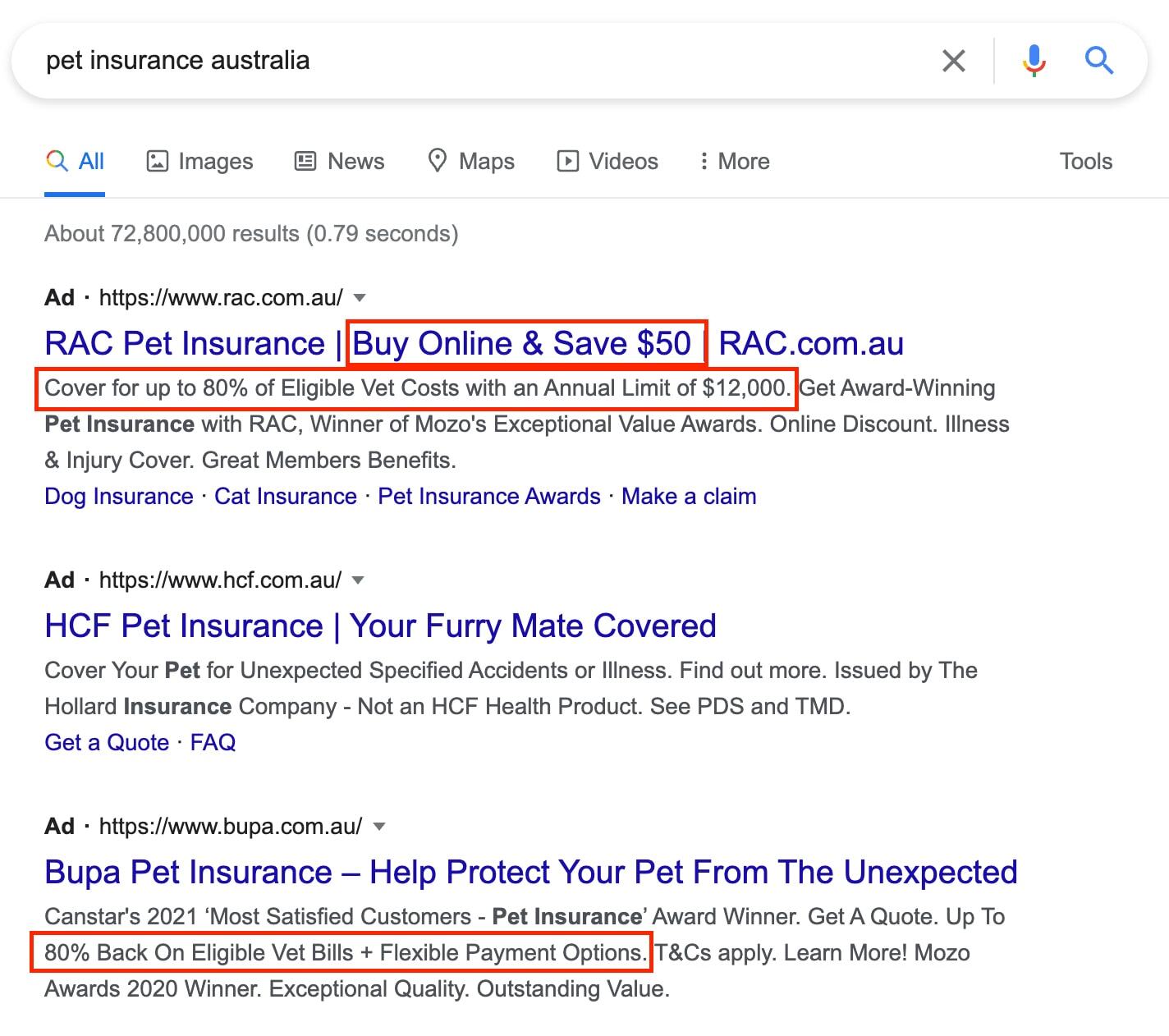
Source: google.com
Customize & Personalize
According to a 2017 survey by Econsultancy, 39% of brands saw a considerable uplift in conversions after implementing personalization in their search engine marketing efforts, and 54% saw a minor uplift.
The great thing about this is that you can easily enhance your ad copy by adding custom attributes like text, numbers, price, date, etc.
IMAGE: IMPROVE COPY WITH CUSTOMIZATION
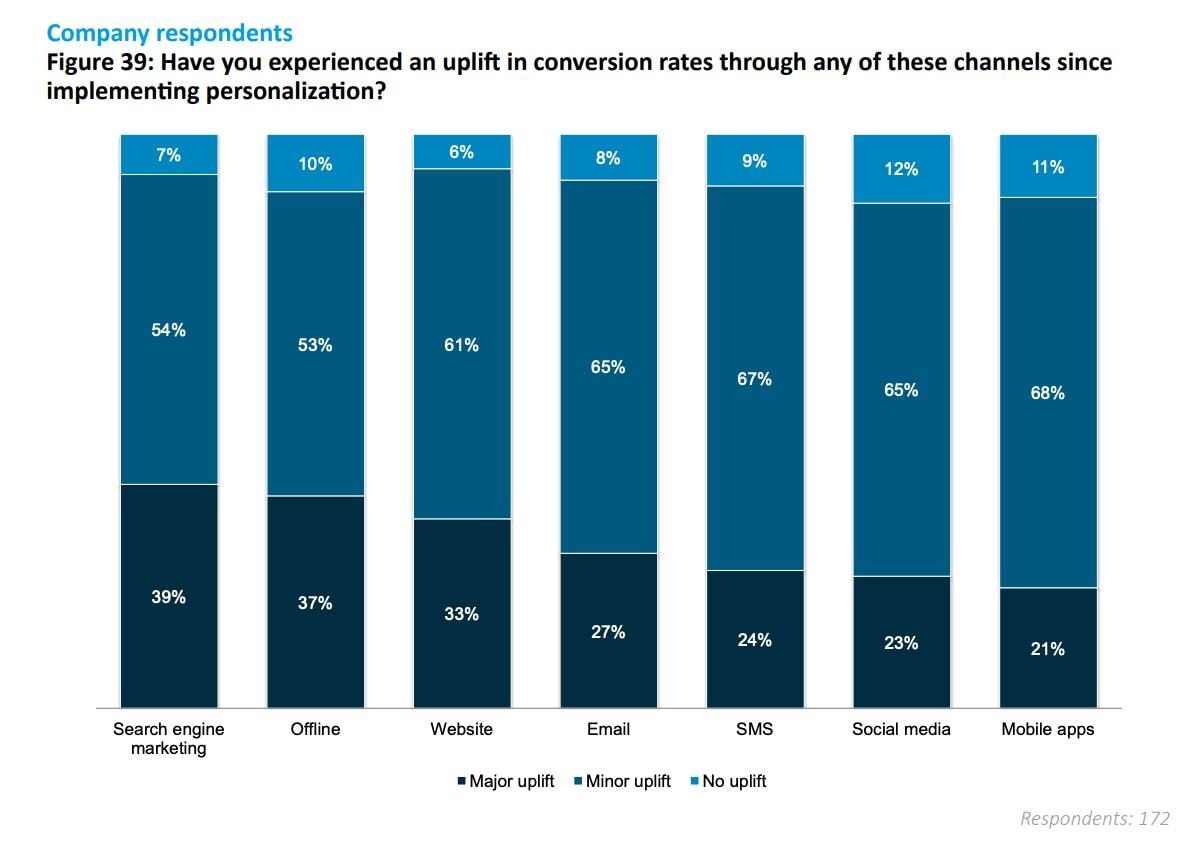
Source: info.redeye.com
Choose the Correct CTAs
If you’re writing copy for Facebook ads, one of the essential things you have to consider is what CTA to use. Understand that consumers inhabiting different stages of the buyer’s journey tend to respond to various calls-to-action.
So, if your ads are targeting the awareness stage, use something akin to “learn more,” as used by Mercedes-Benz Cars UK.
But, if you’re retargeting people who have already visited your website or even made a purchase in your ecommerce store, you can get a bit more sales-y and choose words like “shop,” “call,” “buy,” “book,” etc.
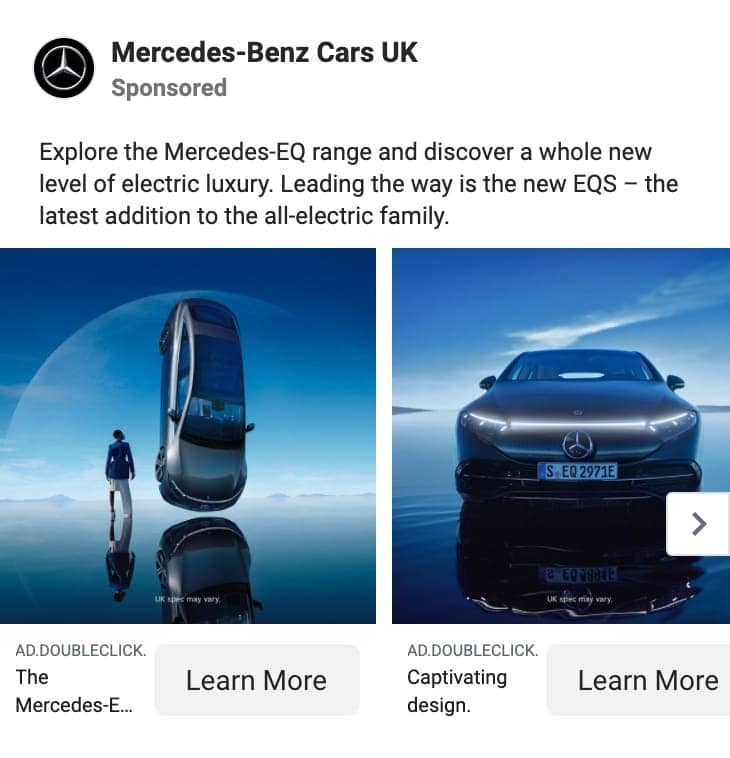
Source: facebook.com
Measure Results & Use Them to Make Your Landing Pages Better
Finally, as you approach the copywriting process for adverts, don’t forget to keep an eye on your analytics and data and make changes where necessary.
If you find phrases that drive impressive conversions, don’t hesitate to add them to your landing pages, like Zenni did, whose Google Ad we mentioned earlier in this section.
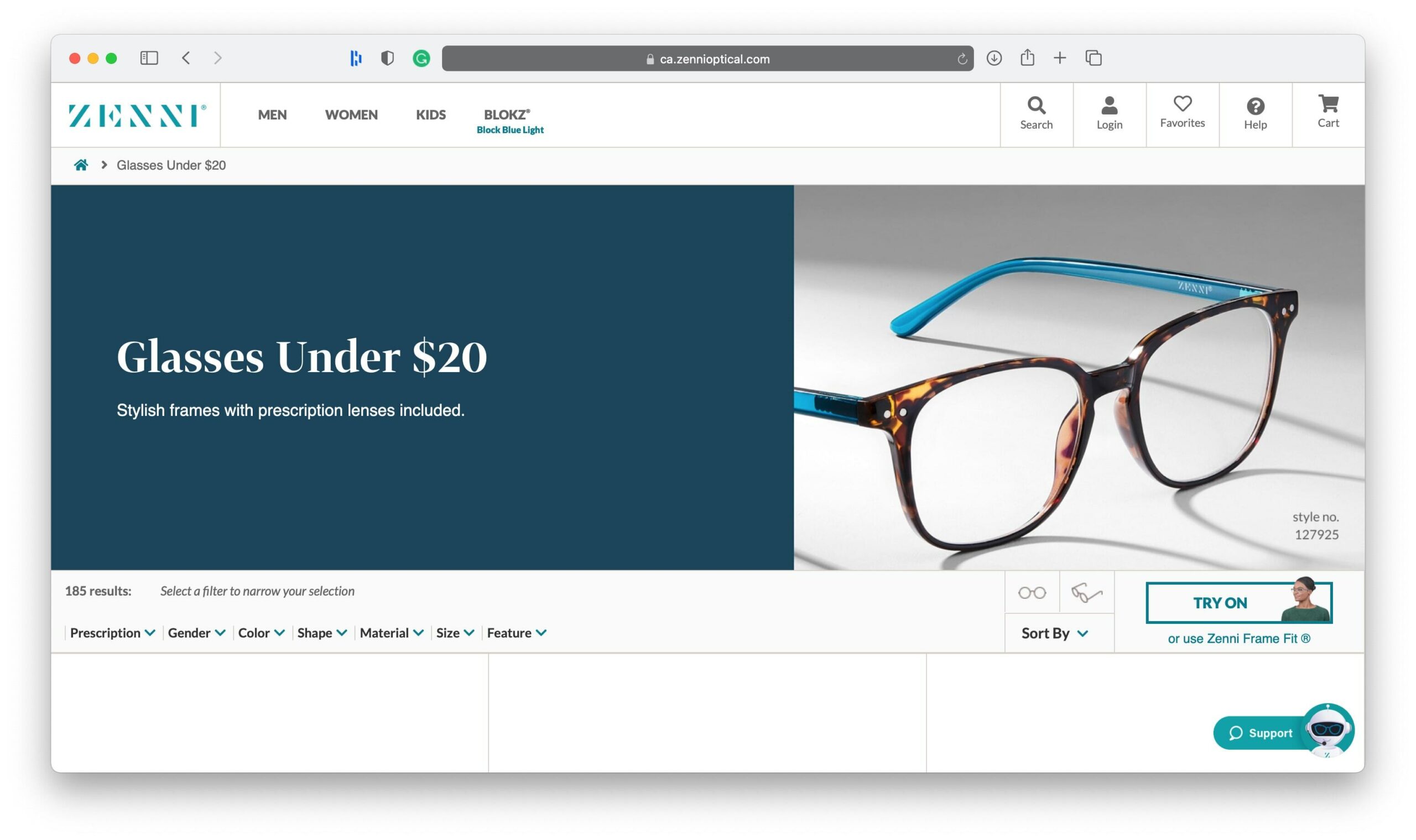
Source: zennioptical.com
Social Media Posts & Interactions
The most notable benefit offered by a well-developed social media strategy is that it allows you to meet your potential customers in a space they enjoy inhabiting. Essentially, this means you can raise awareness and communicate the benefits of your products/services without:
- A) Spending money on ads;
- B) Coming off as a brand that’s entirely focused on sales
But, to really make social media marketing pay off, you have to know how to write showstopping copy for your posts, as well as how to interact with your followers.
Remember It’s Entertainment
Research suggests that most young users go on social media platforms to stay up to date on current news or to find funny and entertaining content.
This should be a clear sign that your voice on these platforms needs to be exciting and engaging.
You can also adopt a funny, edgy, or controversial tone, but make sure that it’s the right choice for your brand. Take a look at how Lazy Oaf managed to find the right balance between likable and unique on its social media profiles. And, based on likes and comments counts, the tone seems to be appealing to its audience.

Source: instagram.com
Balance Professionalism
Even if you’re trying to be funny and approachable, you have to remember that value and trust sell better than design or personality. So don’t forget that your posts still need to be informative and communicate your dedication to providing a superb customer experience.
Adobe does a great job of writing copy for its social media profiles. Its tweets are super easy to consume, most are conversation starters, and a good chunk of them offer a solid amount of value, usually through educational content.
 Source: twitter.com
Source: twitter.com
Prioritize Click-Through Rates
Finally, as you approach the copywriting process for your social media profiles, don’t forget that your ultimate goal is to boost sales with captivating copy.
This means that your posts must include compelling calls-to-action, highlighting the unique value your followers get by going to your site and investing their hard-earned money in your products.
Wolverine does a fantastic job with its Facebook ads, where it advertises 20% savings on its limited bundling offer.
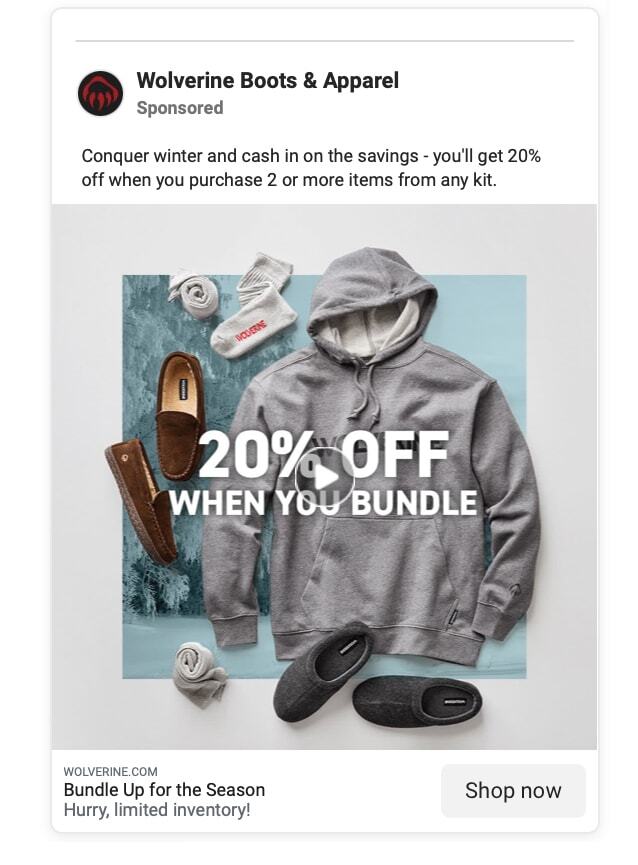
Source: facebook.com
Homepages
When it comes to your digital calling card — your website — the purpose of your copy should be to represent your brand in a way that will appeal to your target audience and inspire sales.
To achieve this effect, make sure to utilize words and phrases that will create a connection between your company and your potential customers, communicate the value you offer, and show that you’re a brand that puts its customers first.
Showcase Your Values
Over the past couple of years, shoppers have made a notable shift towards conscious consumerism, which means that they’re looking to support brands whose values align with their own.
So, one easy copywriting tip is to make sure your homepage copy reflects your audience’s values. That way, you can effectively connect with web visitors, turning them into viable leads, then slowly nurturing them with your quality products and service towards becoming repeat customers.
Check out how brilliantly Transparent Labs does this with the “Our promise” section of its homepage, where it highlights transparency, science-based ingredients, quality, and integrity as the leading principles behind its products.
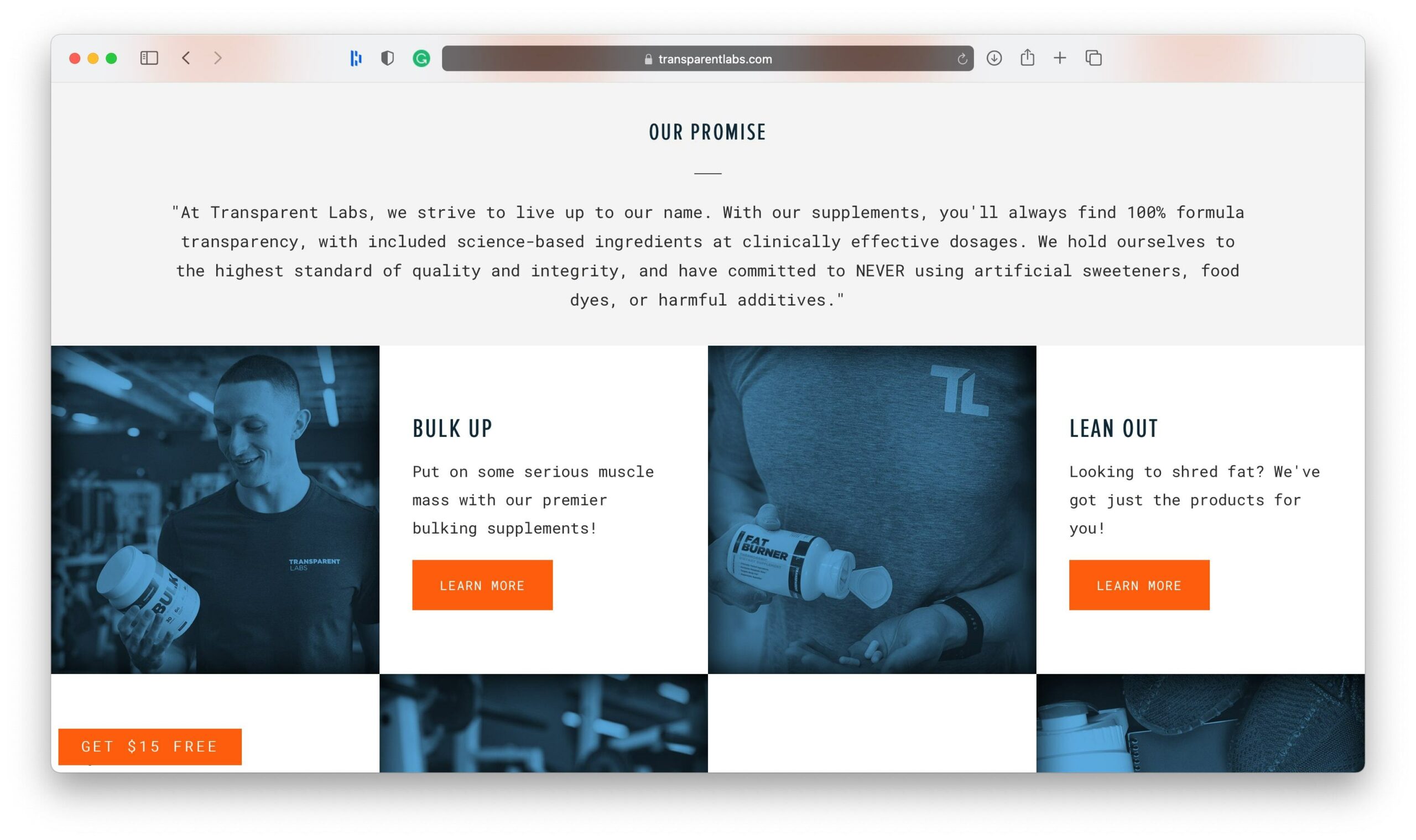
Source: transparentlabs.com
Strike the Right Tonal Balance
You should have a no-nonsense attitude towards customer satisfaction. Nonetheless, you still have to remember that sales-oriented copy has to be interesting enough to make your website visitors stop and think about your products.
So do your best to find the right balance between catchy taglines and data-backed convincing value propositions.
SomniFix does this spectacularly with its “Don’t be a mouth-breather” header that sounds funny but is followed by solid industry terms and claims.
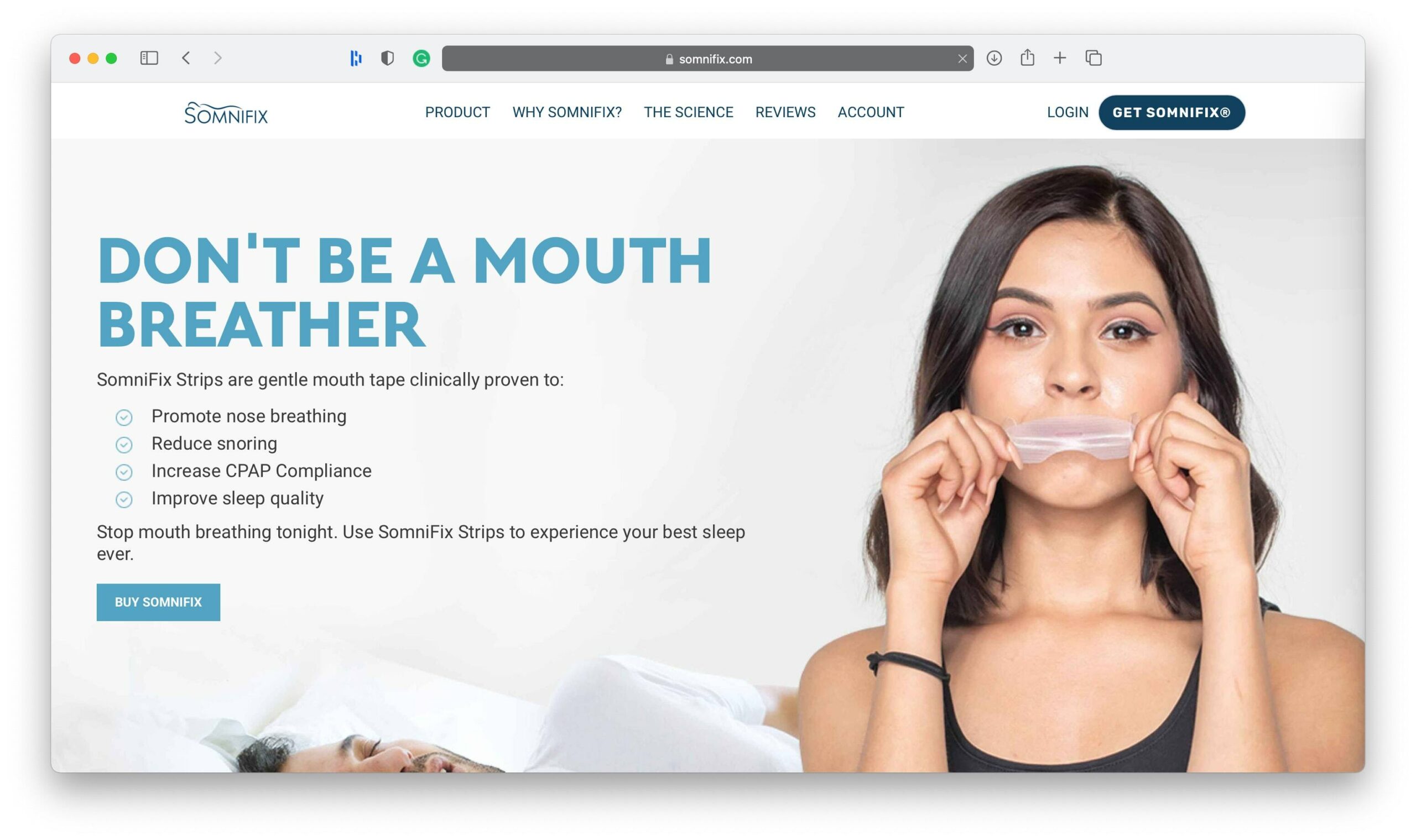
Source: somnifix.com
Differentiate Yourself
With millions of ecommerce stores operating in 2021, you’re probably not the only player in your niche. Naturally, this means that you need to find a way to express that your store is unique and offers something new or better than your competition.
Well-written homepage copy can do that for you. Just think about the benefits that no one else in your industry offers.
GILI Sports, for example, figured out that unique feature to be its products’ space-saving design.
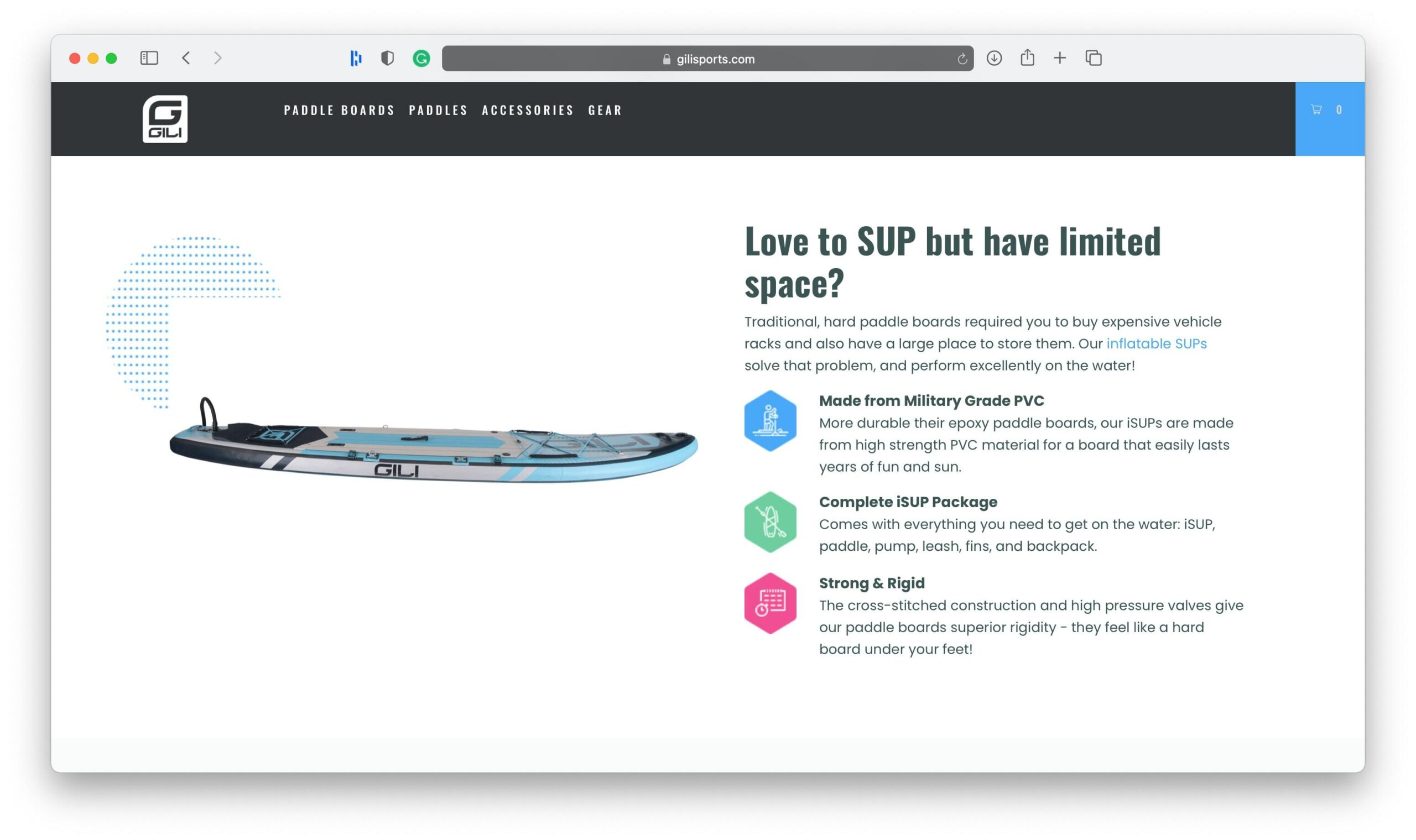
Source: gilisports.com
Prioritize Benefits Over Features
Website copy plays an irreplaceable part in defining and positioning your brand. But remember, the true purpose of your company will always be to make your clients happy.
So don’t forget to plan the copywriting process with a customer-oriented attitude.
Tell website visitors what your products do for them. You don’t have to go into detail — you can very well do what Coola does and use no more than four words. But make sure that those words are what your audience wants to hear (and what your brand can deliver).

Source: coola.com
Product Pages
Once you’ve captured people’s attention, it’s time to optimize your product pages to be as convincing as possible.
In addition to breathtaking product photography and a UX that seamlessly guides page visitors towards becoming clients, your copy also plays a role in convincing people to buy.
Generally, you can drive sales by zooming in on the most relevant aspects of your products and finding phrases that appeal to your audience.
The following are excellent strategies you can implement on your product pages.
Make Bold but Reasonable Claims
One of the best ways to inspire sales is to instantly grab user attention on your product pages. Do this with impressive claims (along the lines of Apple’s “best smartphone ever” line).
Don’t forget to provide proof of what you’re promising to potential buyers.
Check out how Drunk Elephant does it in the example below. It grabs attention by promising “dramatic improvement in the appearance of skin’s texture, tone, radiance, and bounce.” But it also makes sure to support the claim by going into detail in the ingredients section of the page.
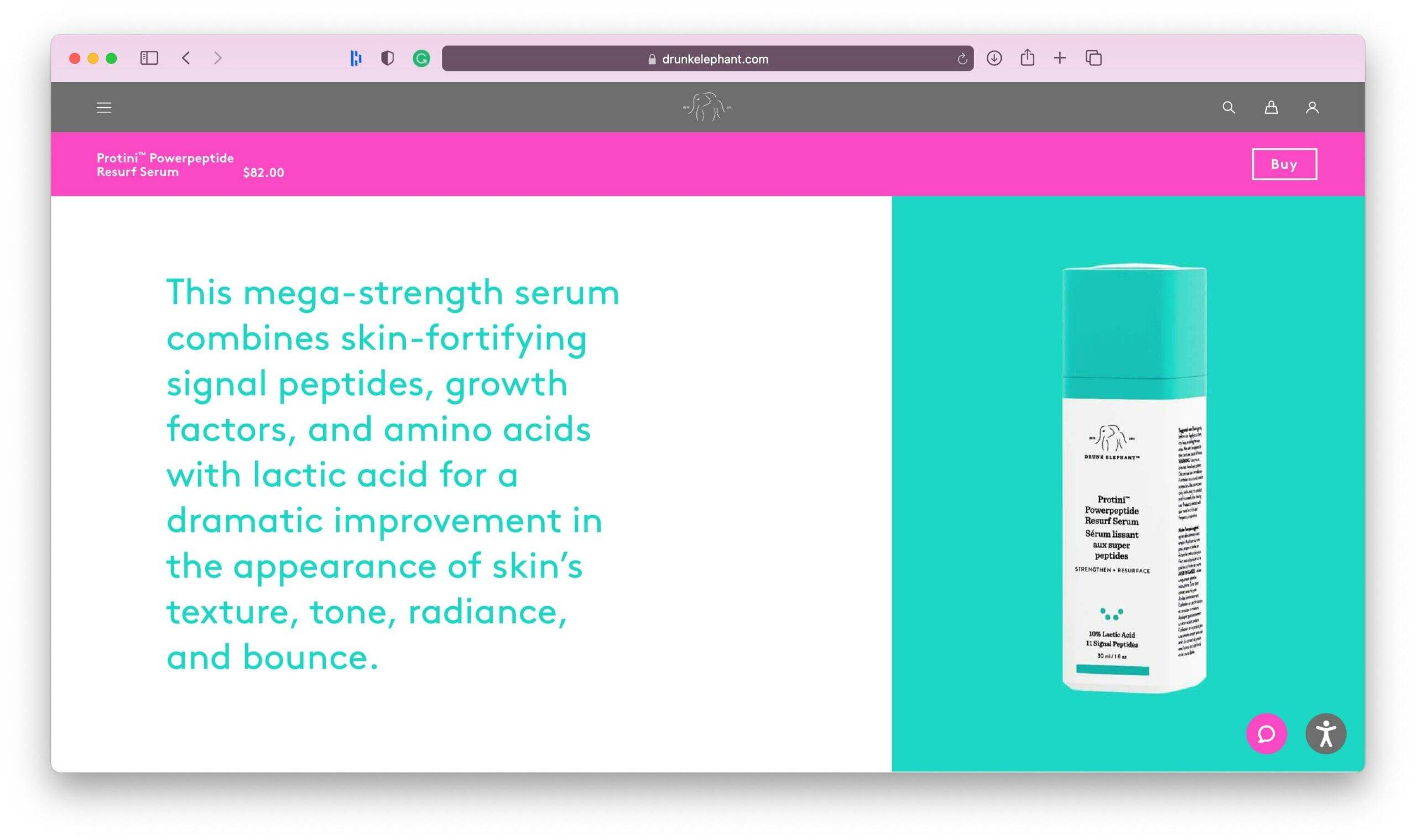
Source: drunkelephant.com
Cover Tangible Benefits
Another super-successful copywriting strategy for product pages is not to get hung up on features.
Yes, product features make your offer better than your competition’s, but ultimately, your audience doesn’t care about technicalities as long as it feels the benefits of those features. So try to describe tangible benefits.
Thomas Farthing, for example, doesn’t just say that its sweaters are made with the best wool out there. But, instead, it points out that they’re made “for a lifetime of adventure,” which does a superb job of communicating their quality.
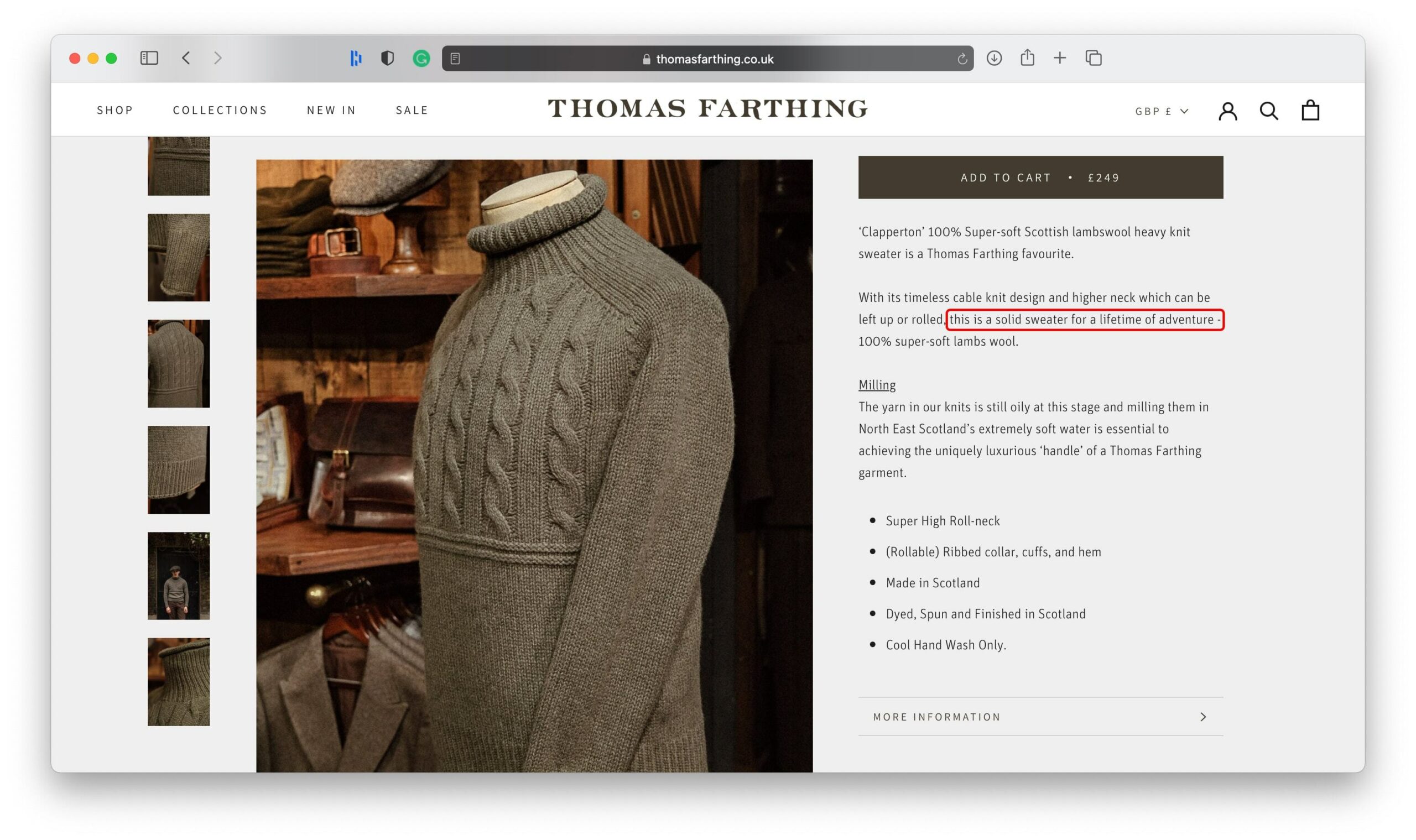
Source: thomasfarthing.co.uk
Hit the Right Emotional Notes
Finally, don’t forget that people don’t necessarily make purchasing decisions based on objective thinking.
More often than not, they’re swayed by emotional language and imagery, so make sure that your copy stirs emotion.
Take a nostalgic approach like Mixam does below. Or tell stories about your products. You can even appeal to your audience’s frustrations to show how well you can solve their needs. Just make sure that you leave a lasting impact and position your brand and products as the answer.
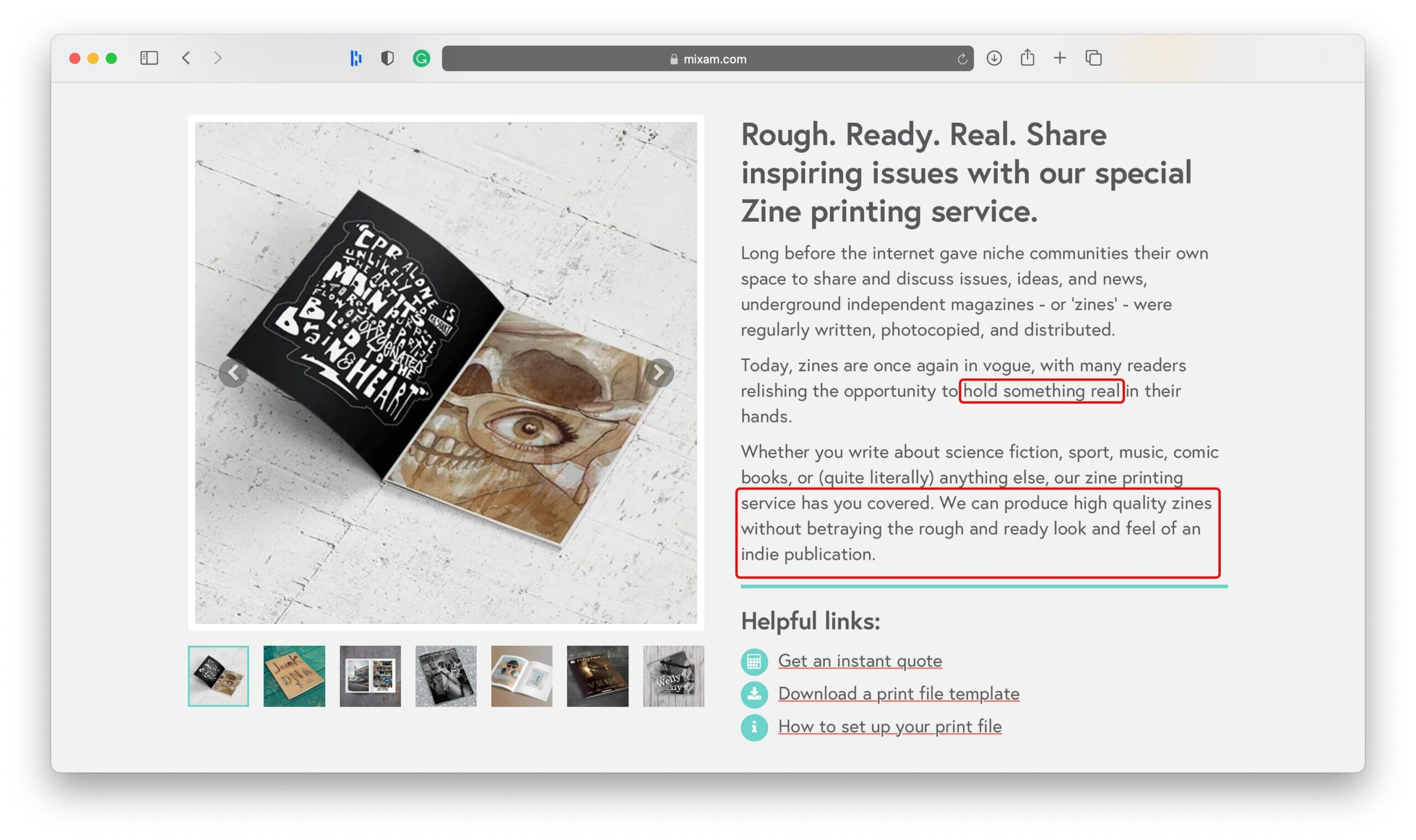
Source: mixam.com
Page HTML Titles & Meta Descriptions
As we explore ecommerce copywriting, it would be foolish not to (briefly) touch upon the importance of every single instance of text associated with the product you want to sell.
What does this mean? It’s simple. It means you need to apply your copywriting knowledge even to the tiniest pieces of copy on your website. In addition to UX text, this also includes HTML titles and meta descriptions.
Seeing how these are the first samples of your brand’s language that potential buyers are likely to see, these spaces give you a precious opportunity to make a great impression.
For an illustration of a brand that hits the right note with its meta descriptions, check out Bloom & Wild.
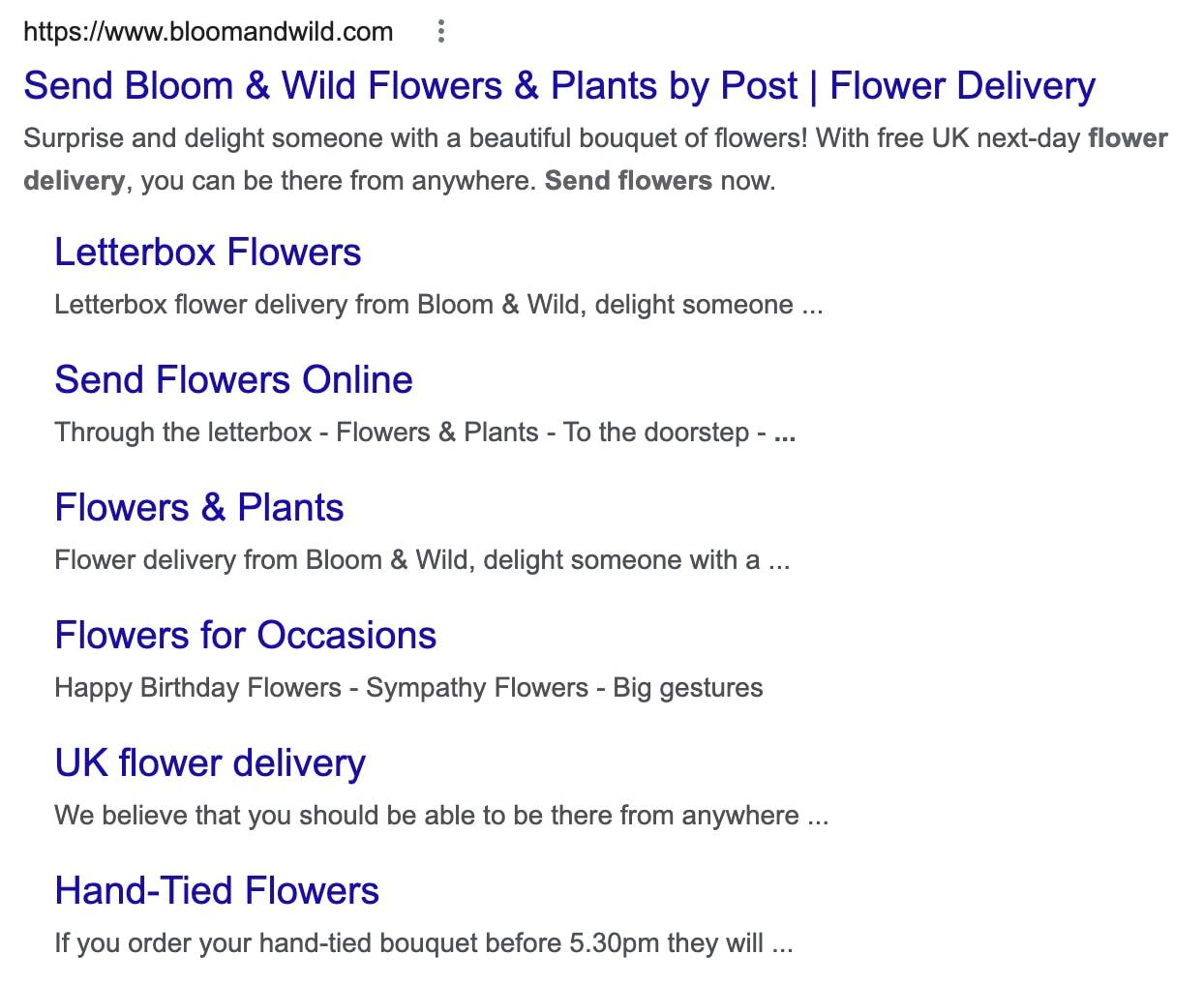
Source: google.com
As you can see, the meta descriptions added to each of the brand’s pages do an excellent job of describing what customers can expect.
In addition to using emotional language that includes words like “surprise” and “delight,” the brand’s copywriters also properly formatted each web section. They made it super-easy for potential customers to land on pages that answer their needs, significantly boosting the chances of converting web visitors into buyers.
About Pages
Another part of your website that you definitely do not want to neglect is your About page.
As you try to enrich your website with language that sells, remember that the attributes that drive sales include trust, authority, and your brand’s values. And what better space to communicate these than your brand’s About page?
In addition to expanding on the values you listed on your homepage, a well-written About page gives you the priceless opportunity to tell your brand’s story by using emotional language — like in this example from Depop.
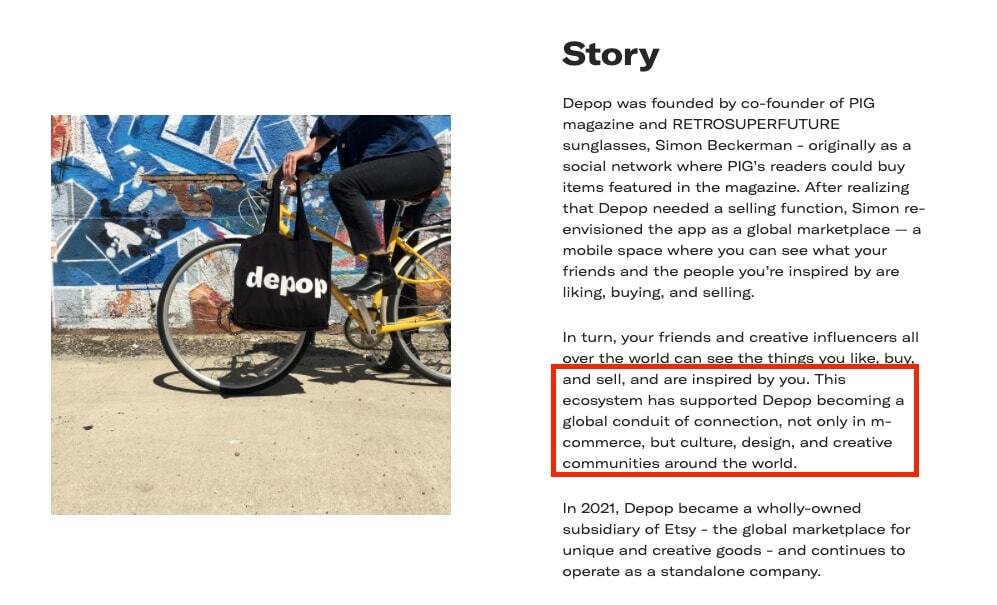
Source: depop.com
And it also provides credentials that support your expertise. Icebreaker, for example, has an extensive About page that provides information about every single part of the company’s practices, including explanations of the supply chain, a list of its materials growers, and even employee profiles.
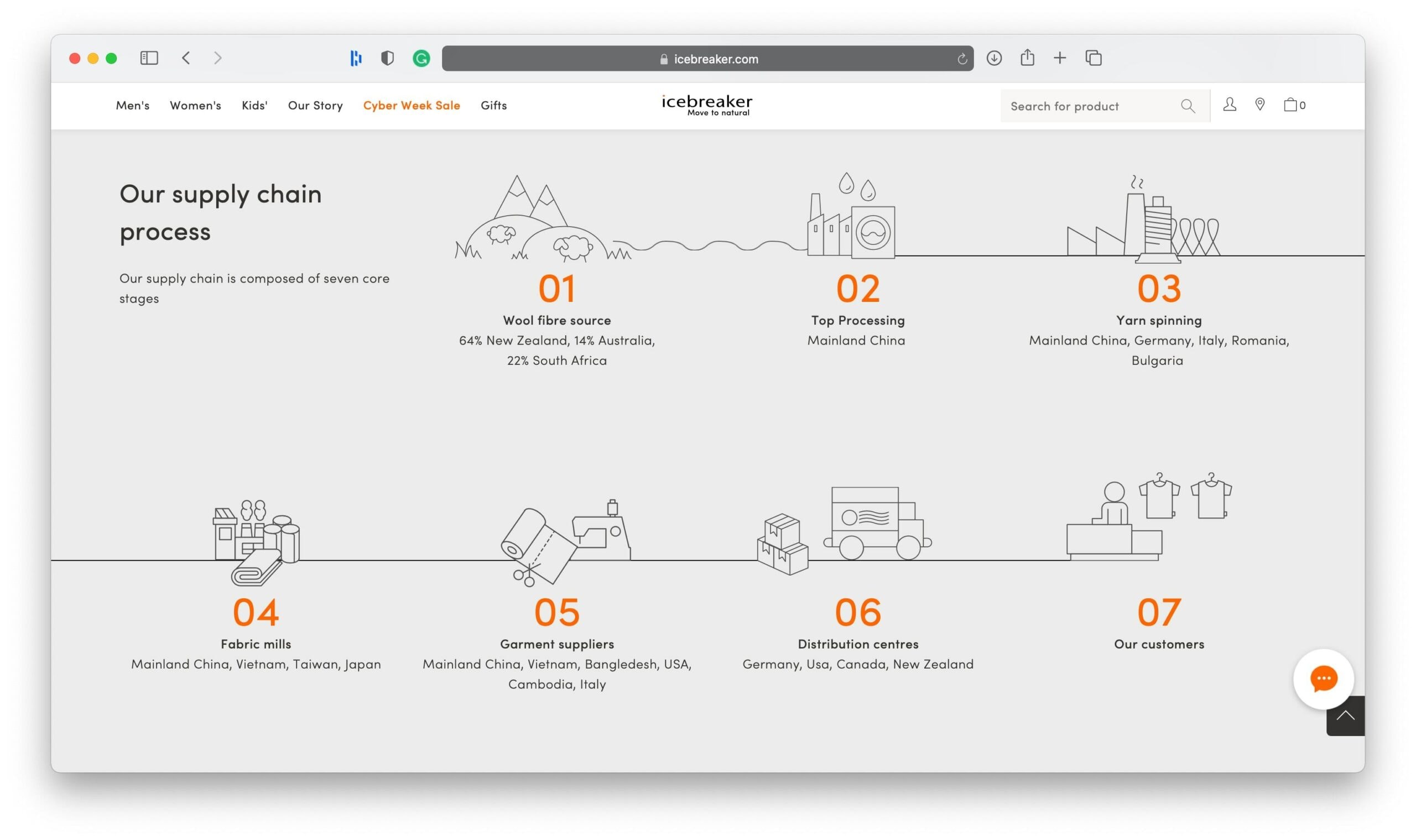
Source: icebreaker.com
Plus, it can even forge a connection with web visitors by describing your mission and explaining how you plan on making people’s lives better, as Deliverr does.
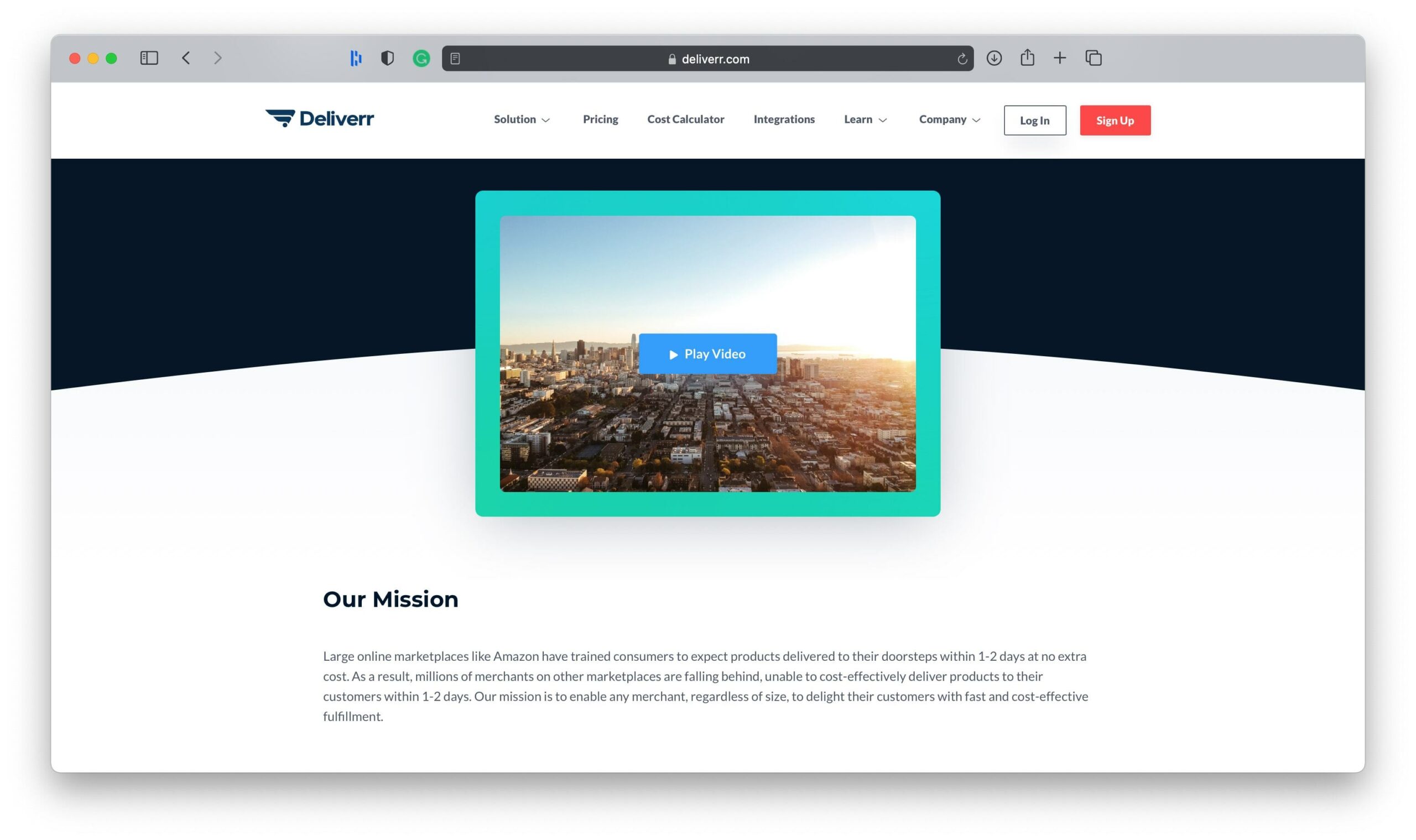
Source: deliverr.com
Over to You: Boost Ecommerce Sales by Nailing the Copywriting Process
There you have it, some of the essential points you need to keep in mind while producing ecommerce copy that sells.
As you can see, much of what you will achieve depends on extensive research and finding the right voice to appeal to your audience.
But, just to be sure that your copy delivers results, do your best to avoid the common mistakes of watering your language down with too much fluff or too many adjectives, writing copy that’s sterile and doesn’t represent your brand’s personality, or, worst of all, doing all your writing in a single sitting without going back to edit (or check your grammar).
And, of course, for the best results, you will have to continually work on making your website copy better.
So don’t forget to test, make seasonal changes, and keep an eye on your audience’s reactions. Chances are, they’re already giving you the hints you need to write the best possible copy there is. All you have to do is open your ears.



